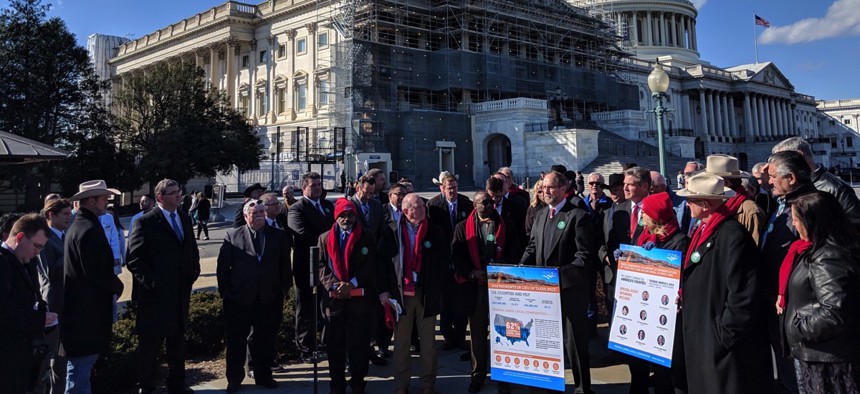Counties Push for Sustainable Public Lands Payment Programs

County officials gathered outside the U.S. Capitol on Tuesday to push for public lands payment programs. Dave Nyczepir / Route Fifty
Local and federal officials argue two funding streams they count on are part of a “social safety net” for primarily rural, Western jurisdictions.
WASHINGTON — County officials took to the U.S. Capitol on Tuesday to advocate for public lands payment programs like Secure Rural Schools, which was reauthorized in a 2018 spending package and dries up this year.
SRS was created by 2000 legislation to be a safety net for local governments seeing their share of revenues decline along with logging on federal lands. Despite the name, the program funds everything from public safety to road maintenance.
Sen. Ron Wyden, an Oregon Democrat, said SRS was intended to get “counties off the fiscal rollercoaster” but didn’t exactly end up that way with the federal government forced to sell off its helium reserves one year and petroleum the next to cover program costs before its reauthorization.
“When SRS was not authorized, we were having conversations on what roads we were going to grind up,” said Mark Owens, a commissioner of Harney County, Oregon.
In September, Wyden, the ranking Democrat on the Senate finance committee floated the possibility of remaking SRS into an endowment program that counties—rural, Western ones in particular—can opt into.
Details are scarce, but Sen. Mark Crapo, the senior Republican on the finance committee after Sen. Chuck Grassley, and Sen. Jeff Merkley, the ranking Democrat on the Senate appropriations committee, are also on board.
“This is going to be a challenge,” Wyden said. “Once again, we're going to have to educate congressmen.”
Merkley hails from Douglas County, the most timber-dependent county in the United States.
The federal government’s slow reauthorization of SRS had many constituents worried proposed local tax measures were intended replacements for the federal commitment, rather than separate revenue streams for other projects.
“It undermined a lot of local initiatives,” Merkley said.
County officials, who were at the Capitol on Tuesday as part of this year’s National Association of Counties conference, also pushed for full restoration of mandatory Payments in Lieu of Taxes funding, which compensates their jurisdictions for nontaxable federal land within their boundaries. Almost 62 percent of counties have some federal land within their boundaries, and in fiscal year 2018 they received a record $552.8 million in PILT payments.
“These payments aren’t earmarks; they aren’t handouts,” said Rep. Derek Kilmer, who sits on the House appropriations committee.
Instead they go to “communities that can’t generate tax revenues on their own,” he said, so they don’t have to choose between funding police or teachers and see an outflow of young workers.
Washington State received $29 million in PILT payments in 2018, which jurisdictions like Klickitat County spent on public health, the hiring of sheriff’s deputies and senior services, said Dave Sauter, a county commissioner.
In Santa Barbara County, California, PILT helps fund a variety of social services including mental health care, said Steve Lavagnino, chair of the Board of Supervisors.
“PILT is part of that fabric of the social safety net,” Lavagnino said. “PILT helps us place that kid in foster care.”
Dave Nyczepir is a News Editor at Route Fifty and is based in Washington, D.C.
NEXT STORY: Is This The End of Recycling?






